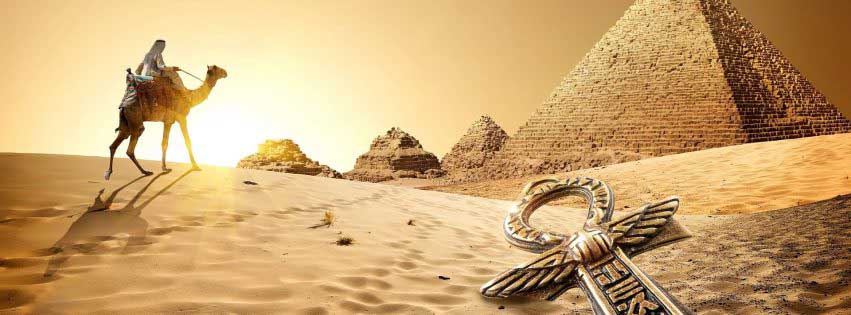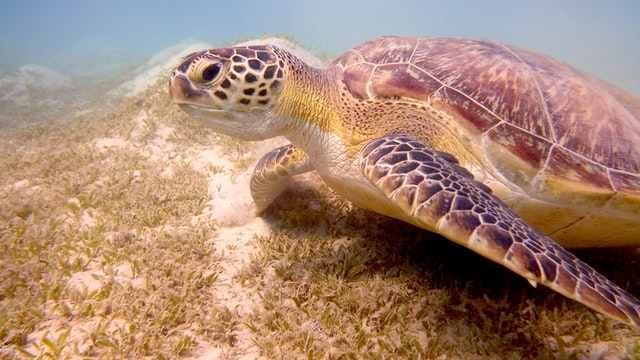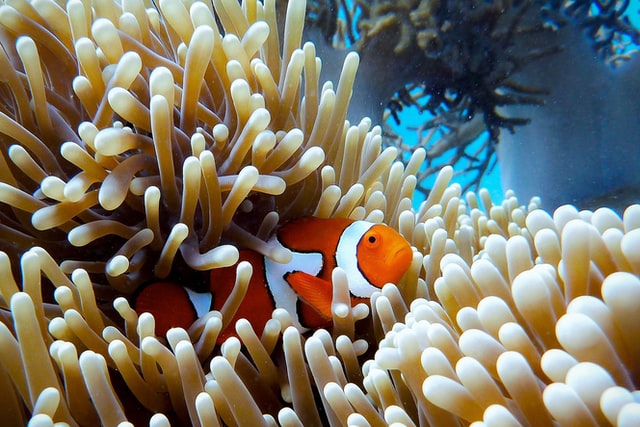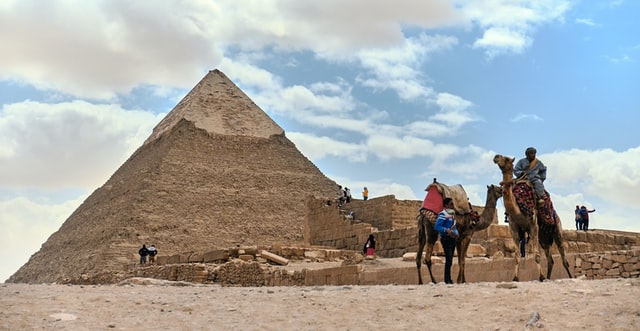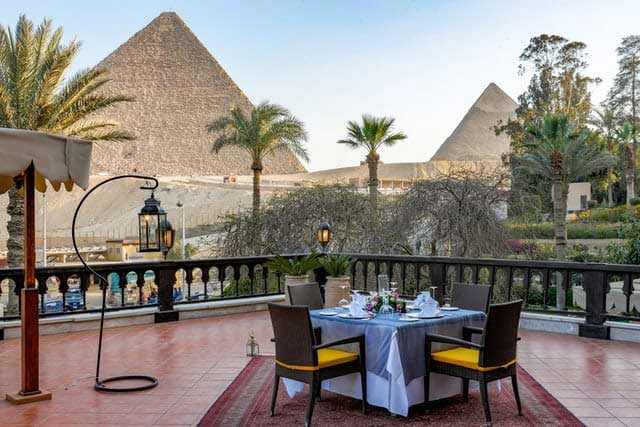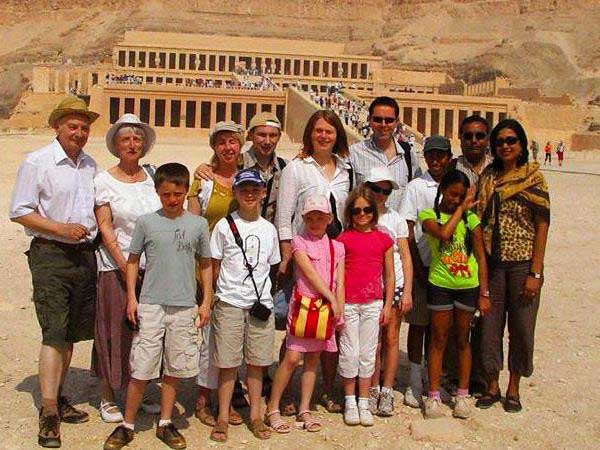The Egyptian Cat Goddess Bastet
Lion and cat and woman, goddess of war and fertility—the Egyptian goddess Bast (also known as Bastet) contains multitudes. While she’s not the only cat goddess from ancient history, Bastet is probably the most famous cat goddess today. She has a strong presence in pop culture and a select few even still worship her!
Bastet, goddess of cats, is one of the most well-known figures of the Egyptian pantheon. She’s been known as both Bast and Bastet. Her main attributes include being the Protector of lower Egypt, the patron goddess of cats and firefighters, and being a goddess of the sun, war, fertility, music, and celebration!
Bastet is the Egyptian goddess of the home, domesticity, women’s secrets, cats, fertility, and childbirth. She protected the home from evil spirits and disease, especially diseases associated with women and children. As with many deities in Egyptian religion, she also played a role in the afterlife.
She is sometimes depicted as a guide and helper to the dead although this was not one of her primary duties. She was the daughter of the sun god Ra and is associated with the concept of the Eye of Ra (the all-seeing eye) and the Distant Goddess (a female deity who leaves Ra and returns to bring transfromation). Bastet was one of the most popular deities of ancient Egypt as she was the protector of everyone’s home and family.
Bastet was extremely popular throughout Egypt with both men and women from the Second Dynasty of Egypt (c. 2890 – c. 2670 BCE) onward with her cult centered at the city of Bubastis from at least the 5th century BCE. She was first represented as a woman with the head of a lioness and closely associated with the goddess Sekhmet but, as that deity’s iconography depicted her as increasingly aggressive, Bastet’s images softened over time to present more of a daily companion and helper than her earlier forms as savage avenger
This article contains information about the Egyptian goddess Bastet including:
- Who is Bastet?
- Bastet’s family
- Bastet attributes
- Bastet as a protector warrior
- Cats in Ancient Egypt
- Temple of Bastet at Bubastis
- Holi Festival
- The worship of Bastet
- Heroduts describes temple of Bastet
- Bastet’s Popularity and Amulets of Cats
- How Bastet Was Worshipped?
- Bastet Myths
- best travel packages to Egypt
- Tips and advices before visiting Egypt

Who is Bastet ?
Bastet or Bast was a goddess of ancient Egyptian religion, worshiped as early as the Second Dynasty (2890 BCE). Her name also is rendered as Baast, and Baset. In ancient Greek religion, she was known as Ailuros .
Bastet, goddess of cats, is one of the most well-known figures of the Egyptian pantheon. She’s been known as both Bast and Bastet. Her main attributes include being the Protector of lower Egypt, the patron goddess of cats and firefighters, and being a goddess of the sun, war, fertility, music, and celebration!
Bastet was worshiped in Bubastis in Lower Egypt, originally as a lioness goddess, a role shared by other deities such as Sekhmet. Eventually Bastet and Sekhmet were characterized as two aspects of the same goddess, with Sekhmet representing the powerful warrior and protector aspect and Bastet, who increasingly was depicted as a cat, representing a gentler aspect.
Bastet’s family
• Bastet was most commonly considered a daughter of either Ra and Isis or just Ra alone. In her aspect as the “eye of Ra,” she was a part of him given independent life.
• She was the mother of the god Mahes, a lion or lion-headed man.
• In later years she was known as the mother of Nefertum, a god of the sun, perfume, and alchemy.
• She was the wife of Ptah, the god of architecture and craftsmanship.
• Anubis was sometimes cited as either the son or husband of Bast, because of her status as goddess of perfume and his as god of embalming, but this was not one of her most important relationships.
Bastet attributes
As one of the main goddesses of the Egyptian pantheon, Bastet had a huge number of attributes and aspects:
• She was a goddess of cats, the sun, of the East, of fire, of love, intoxication, music and dancing, joy, celebration, fertility, secrets, magic, and sex.
• However, she was also a goddess of war known for her wrathful vengeance.
• She protected households and individuals from disease and evil spirits, guarded pregnant women, and protected cats.
• She served as the divine nurse and mother of the Pharaoh.
• Due to Bastet meaning “she of the ointment jar” she also became known also as a goddess of perfume, and was called the “perfumed protector.”
• Bast/Bastet was the protector and guardian of Lower Egypt.
• She was the patron goddess of fire fighters, because the Egyptians believed that a cat running through a building on fire would draw the flames out.
• She was also one of the goddesses who was known as the “eye of Ra” or the “eye of Atum,” the sun. In this aspect she symbolized Ra’s feminine counterpart and was sent out to take vengeance on his enemies. The “eye of Ra” was both a part of Ra and a separate being from him, and was considered his mother, sister, wife, and daughter simultaneously. She had life-giving, protective and also destructive capacities.
Bastet as a protector warrior
Bastet was originally a fierce lioness warrior goddess of the sun worshiped throughout most of ancient Egyptian history, but later she became Bastet, the cat goddess that is familiar today. She then was depicted as the daughter of Ra and Isis, and the consort of Ptah, with whom she had a son Maahes.
As protector of Lower Egypt, she was seen as defender of the king, and consequently of the sun god, Ra. Along with other deities such as Hathor, Sekhmet, and Isis, Bastet was associated with the Eye of Ra. She has been depicted as fighting the evil snake named Apep, an enemy of Ra. In addition to her solar connections, sometimes she was called “eye of the moon“.
Bastet was also a goddess of pregnancy and childbirth, possibly because of the fertility of the domestic cat.
Bastet was also depicted as the goddess of protection against contagious diseases and evil spirits.
Cats in Ancient Egypt
Cats in ancient Egypt were highly revered, partly due to their ability to combat vermin such as mice, rats (which threatened key food supplies), and snakes—especially cobras. Cats of royalty were, in some instances, known to be dressed in golden jewelry and were allowed to eat from the plates of their owners. Dennis C. Turner and Patrick Bateson estimate that during the Twenty-second Dynasty (c. 945–715 BC), Bastet worship changed from being a lioness deity into being predominantly a major cat deity. Because domestic cats tend to be tender and protective of their offspring, Bastet was also regarded as a good mother and sometimes was depicted with numerous kittens.
The native Egyptian rulers were replaced by Greeks during an occupation of Ancient Egypt in the Ptolemaic Dynasty that lasted almost 300 years. The Greeks sometimes equated Bastet with one of their goddesses, Artemis.
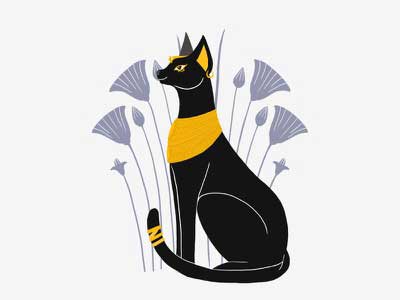
Bubastis
Temple of Bastet at Bubastis
Bubastis town lay in the Nile Delta near what is known today as Zagazig. Bastet was the local deity of this town.
At the Bubastis temple, some cats were found to have been mummified and buried, many next to their owners. More than 300,000 mummified cats were discovered when Bastet’s temple was excavated. Turner and Bateson suggest that the status of the cat was roughly equivalent to that of the cow in modern India. The death of a cat might leave a family in great mourning and those who could, would have them embalmed or buried in cat cemeteries—pointing to the great prevalence of the cult of Bastet. Extensive burials of cat remains were found not only at Bubastis, but also at Beni Hasan and Saqqara. In 1888, a farmer uncovered a burial site of many hundreds of thousands of cats in Beni Hasan.
Her cult center at Bubastis in Lower Egypt became one of the richest and most luxuriant cities in Egypt as people from all over the country traveled there to pay their respects to the goddess and have the bodies of their dead cats interred in the city. In Egyptian art, her iconography borrowed from the earlier goddess Mafdet and also from Hathor, a goddess associated with Sekhmet who was also closely linked to Bastet.
Holi Festival
Herodotus relates that of the many solemn festivals held in Egypt, the most important and most popular one was that Holi celebrated in Bubastis in honor of this goddess. Each year on the day of her festival, the town was said to have attracted some 700,000 visitors, both men and women (but not children), who arrived in numerous crowded ships. The women engaged in music, song, and dance on their way to the place. Great sacrifices were made and prodigious amounts of wine were drunk—more than was the case throughout the year. This accords well with Egyptian sources that prescribe that lioness goddesses are to be appeased with the “feasts of drunkenness”. A festival of Bastet was known to be celebrated during the New Kingdom at Bubastis. The block statue from the eighteenth dynasty (c. 1380 BC) of Nefer-ka, the wab-priest of Sekhmet, provides written evidence for this. The inscription suggests that the king, Amenhotep III, was present at the event and had great offerings made to the deity.
The people of Egypt came annually to the great festival of Bastet at Bubastis which was one of the most lavish and popular events of the year. Geraldine Pinch, citing Herodotus, claims, “women were freed from all constraints during the annual festival at Bubastis. They celebrated the festival of the goddess by drinking, dancing, making music, and displaying their genitals”. This “raising of the skirts” by the women, described by Herodotus, had as much to do with freedom from social constraints as it did with the fertility associated with the goddess. As with many of the other festivals throughout Egypt, Bastet’s celebration was a time to cast aside inhibitions much in the way modern revelers do in Europe during Carnivale or in the United States at Mardi Gras.
Herodotus presents a vivid picture of the people traveling to Bubastis for the festival:
When the people are on their way to Bubastis, they go by river, a great number in every boat, men and women together. Some of the women make a noise with rattles, others play flutes all the way, while the rest of the women, and the men, sing and clap their hands. As they travel by river to Bubastis, whenever they come near any other town they bring their boat near the bank; then some of the women do as I have said, while some shout mockery of the women of the town; others dance, and others stand up and lift their skirts. They do this whenever they come alongside any riverside town. But when they have reached Bubastis, they make a festival with great sacrifices, and more wine is drunk at this feast than in the whole year besides. It is customary for men and women (but not children) to assemble there to the number of seven hundred thousand, as the people of the place say.
Although Herodotus claims that this festival outstripped all others in magnificence and excess, in reality there were many festivals celebrating many gods which could claim the same. The popularity of this goddess, however, made her celebration of particular significance in Egyptian culture. In the passage above, Herodotus makes note of how the women in the boats mocked those on shore and this would have been done to encourage them to leave off their daily tasks and join the celebration of the great goddess. Bastet, in fact, was second only to Isis in popularity and, once she traveled through Greece to Rome, was equally popular among the Romans and the subjects of the later Roman Empire.
The worship of Bastet
The goddess was worshipped primarily at Bubastis but held a tutelary position at Saqqara and elsewhere.
The goddess’s popularity grew over time and in the Late Period and Graeco-Roman times she enjoyed great status. The main cult centre of this deity was the city of Bubastis – Tell Basta – in the eastern Delta, and although only the outlines of the temple of Bastet now remain, Herodotus visited the site in the 5th century BC and praised it for its magnificence. The festival of Bastet was also described by Herodotus who claimed it was the most elaborate of all the religious festivals of Egypt with large crowds participating in unrrestrained dancing, drinking, and revelry.
How Bastet Was Worshipped?
Bast/Bastet was worshipped and honored in a variety of ways throughout the history of Egypt.
Mostly visibly, enormous annual festivals to honor Bast were held in her cult center city, Bubastis, involving raucous celebration and intoxication.
In their personal worship, Egyptians also prayed to Bastet to remove disease and guard the household. Egyptian homes displayed statues of Bastet to shield against thieves. Cat amulets worn on the body invoked the protection of Bastet. There were also special Bast amulets with kittens on them that women wore for fertility purposes; the number of kittens on the amulet corresponded with the number of children desired.
Cats were sacred to Bast and were treasured pets in many Egyptian households. (In addition to their religious association, they were highly valued for their vermin-killing abilities!) In the homes of the wealthy, cats wore gold jewelry and were fed lavishly from their owner’s table. People deeply mourned their departed cats and dedicated their mummies to Bastet. At the height of Bastet’s popularity, the penalty for killing a cat—even by accident—was death!
Heroduts describes temple of Bastet
Herodotus is the primary source for information on the cult of Bastet and, unfortunately, does not go into great detail on the particulars of her worship. It seems both men and women served as her clergy and, as with the other Egyptian deities, her temple at Bubastis was the focal point of the city providing services ranging from medical attention to counseling to food distribution. Herodotus describes this temple:
Save for the entrance, it stands on an island; two separate channels approach it from the Nile, and after coming up to the entry of the temple, they run round it on opposite sides; each of them a hundred feet wide, and overshadowed by trees. The temple is in the midst of the city, the whole circuit of which commands a view down into it; for the city’s level has been raised, but that of the temple has been left as it was from the first, so that it can be seen into from without. A stone wall, carven with figures, runs round it; within is a grove of very tall trees growing round a great shrine, wherein is the image of the goddess; the temple is a square, each side measuring a furlong. A road, paved with stone, of about three furlongs’ length leads to the entrance, running eastward through the market place, towards the temple of Hermes; this road is about 400 feet wide, and bordered by trees reaching to heaven.
Bastet’s Popularity and Amulets of Cats
The popularity of Bastet grew from her role as protector of women and the household. As noted, she was as popular among men as women in that every man had a mother, sister, girlfriend, wife, or daughter who benefited from the care Bastet provided. Further, women in Egypt were held in high regard and had almost equal rights which almost guaranteed a goddess who protected women and presided over women’s secrets an especially high standing.
Cats were also greatly prized in Egypt as they kept homes free of vermin (and so controlled diseases), protected the crops from unwanted animals, and provided their owners with fairly maintenance-free company. One of the most important aspects of Bastet’s festival was the delivery of mummified cats to her temple. When the temple was excavated in 1887 and 1889 CE over 300,000 mummified cats were found. Wilkinson, commenting on her universal popularity, writes:Amulets of cats and litters of kittens were popular New Year gifts, and the name of Bastet was often inscribed on small ceremonial ‘New Year flasks’, probably to evoke the goddess as a bestower of fertility and because Bastet, like other lioness goddesses, was viewed as a protective deity able to counter the darker forces associated with the ‘Demon Days’ at the end of the Egyptian year.
Bastet was so popular that, in 525 BCE, when Cambyses II of Persia invaded Egypt, he made use of the goddess to force the Egyptian’s surrender. Knowing of their great love for animals, and cats especially, he had his soldiers paint the image of Bastet on their shields and then arranged all the animals that could be found and drove them before the army toward the pivotal city of Pelusium. The Egyptians refused to fight for fear of harming the animals and offending Bastet and so surrendered.
The historian Polyaenus (2nd century CE) writes how, after his victory, Cambyses II hurled cats from a bag into the Egyptian’s faces in scorn that they would surrender their city for animals. The Egyptians were undeterred in their veneration of the cat and their worship of Bastet, however. Her status as one of the most popular and potent deities continued throughout the remainder of Egypt’s history and on into the era of the Roman Empire until, like the other gods, she was eclipsed by the rise of Christianity.
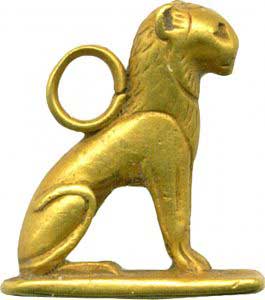
Bastet Myths
There are several famous myths about the Egyptian cat god Bastet:
Slaying of Apep
Apep (sometimes called Apophis) was an underworld serpent god associated with darkness and chaos. He was the greatest enemy of Ra, Bast’s father, and wished to consume everything with darkness and destroy Ra. The priests of Ra tried to hex Apep but none of their spells worked. So Bast, in her cat form (with excellent night vision!), went to Apep’s dark lair and slew him. Apep’s death ensured the sun would continue to shine and crops would continue to grow, and Bast was honored as a goddess of fertility thereafter.
Sekhmet’s Vengeance
When Ra was still a mortal pharaoh, he once felt angry with the people of Egypt. So he released Sekhmet, his daughter, on the people to exact vengeance. She slaughtered huge numbers of people and drank their blood.
Ra felt remorseful and wanted to stop Sekhmet. So he had the people pour red-tinged beer over the land. Then when Sekhmet came across it, she thought it was blood and drank it. Drunken, she fell asleep. And when she awoke, she had transformed into either Hathor or Bast, depending on who is telling the story.
The Origin of Turquoise
A myth from Bubastis posits that turquoise is actually the fallen menstrual blood of the goddess Bastet, which transformed into turqoise as soon as it touched the ground.
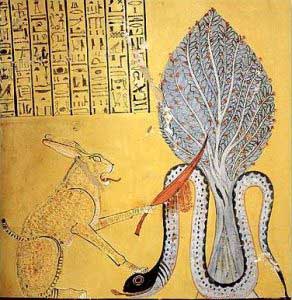
Explore some of our best travel packages to Egypt :
https://www.cruiseera.com/tour/12-days-egypt-tour-package/
https://bastettravel.com/travel-packages/10-days-in-egypt-with-nile-cruise/
https://bastettravel.com/travel-packages/cairo-and-luxor-by-train/
https://bastettravel.com/travel-packages/cairo-alexandria-aswan-and-luxor/
https://bastettravel.com/travel-packages/abu-simbel-sun-festival/
https://bastettravel.com/nile-cruises/princess-sarah-nile-cruise/
https://bastettravel.com/nile-cruises/concerto-nile-cruise/
Frequently asked questions about visiting Egypt
Is it safe to travel to Egypt
Is it safe to travel to Egypt?
Is Egypt Safe for Americans to Travel to
Is Egypt Safe for Americans to Travel to?
We get this question a lot at Bastet Travel In short, Americans and other visitors can rest easy: yes, Egypt is a safe country for tourists. And the rest of the world seems to agree — after years of middling numbers, tourism in Egypt is steadily rising towards its former highs, hosting over 9 million sightseers in 2018. The longer answer is worth exploring, though, and we have some assurances to offer all our clients who join us on all of our Egypt Travel Packages.
Is it safe to visit the Pyramids
Is it safe to visit the Pyramids?
Definitely safe to explore Cairo and visit the pyramids, especially while being accompanied with your guide.
Here are some of the best tours to Pyramids:
Is it allowed to enter The Pyramids in Egypt
Is it allowed to enter The Pyramids in Egypt?
Tourists are allowed to enter all three of the great pyramids, for a fee, of course. That is, you can go into the Great Pyramid of Khufu, the Pyramid of Khafre, and the Pyramid of Menkaure as long as you pay for a ticket. That’s the good news.
The bad news starts with the mundane issues of how hard it can be to get inside. You must first pay for a ticket (around $20) for general admission to the grounds, then for an additional ticket for each pyramid, between about $5 and $15. The total amounts up fast, especially if you’re traveling with your family.
Second, ticket sales are not a smooth procedure. Changes occur in the process regularly, and you can never be sure of exactly what to expect. First, there’s often, but not always, a limit imposed on ticket sales for the smaller pyramids, those of Khufu and Khafre. This is usually 300 tickets per pyramid per day, but only 150 are offered in the morning, the rest are saved until the afternoon. People get annoyed and impatient and you may run into pushing and shoving.
What are the most famous tourist attractions in Egypt
What are the most famous tourist attractions in Egypt?
Egypt has so much for travelers to see and do, it’s the perfect country for a mix of activities combining culture, adventure, and relaxation. Find the best places to visit with our list of the top tourist attractions in Egypt.
- Pyramids of Giza
- Valley of the kings
- Luxor’s Karnak Temple
- The Egyptian Museum
- Christian and Islamic Cairo
- The White Desert and Baharyia Oasis
- Siwa Oasis
- Abu simbel Temples
- Aswan
- Alexandria
- St. Catherine’s Monastery
- The Nubian village
- Nile River Cruise
- Hurghada
- South of Sinai
How Much will I have to pay as a deposit
The fixed deposit amount is 25% of the tours total price Except for Egypt Christmas tours, new years and other peak seasons where the deposit goes up to 50%.
What is the best Nile cruise in Egypt
What is the best Nile cruise in Egypt?
Sonesta Moon Goddess.
Oberoi Philae Nile Cruise.
Oberoi Zahra Nile Cruise.
Sonesta Star Goddess Cruises.
M/S Esplanade Cruise.
Nile Goddess Cruise.
Do and do not in Egypt
Do and do not in Egypt
Do respect the monuments archaeological sites are human heritage don’t touch scratch or sit on it. Do dress correctly whilst there is no specific dress code in the cities, women will feel more comfortable if they do not wear shorts or have their shoulders uncovered.
What do female tourists wear in Egypt
What do female tourists wear in Egypt?
Pants, Capris, Leggings, and Shorts
Basically, as long as your knees are covered, you are good. So whether you choose pants or capris, you will feel comfortable and remain respectful. Local women wear long pants or skirts; however, I wore capris a couple of days with no issues.
What do you wear on a Nile Cruise
What do you wear on a Nile Cruise?
There are no “formal nights” or other theme nights on Nile Cruises, so you can just go with resort casual. Slacks are fine, as are dresses. Bare shoulders are acceptable in the cruise dining room, so feel free to wear what you feel good in.
How Much does a Nile River Cruise Cost
How Much does a Nile River Cruise Cost?
The cost of a standard Nile River cruise between Luxor & Aswan will range from $450 to $750 for 3,4, or 7 nights. The cost of a high Luxury Nile River cruise between Luxor & Aswan will range from $790 to $1299 for 3,4, or 7 nights.
How Much does an Egypt vacation package cost
How Much does an Egypt vacation package cost?
Starting from only $950, a package is your passport to inexpensive travel. Custom build your Egypt trip by choosing from our comprehensive range of airfares, hotels, and rental cars.
What is the best time to visit Egypt
What is the best time to visit Egypt?
How many days are enough to visit Egypt
How many days are enough to visit Egypt?
What are the best day trips in Egypt
Is it a common practice to give tips in Egypt
Is it a common practice to give tips in Egypt?
What kind of Transportation can be used to move in Egypt cities
What kind of Transportation can be used to move in Egyptian cities?
How can I obtain my Visa to visit Egypt?
How can I obtain my visa to visit Egypt?
Is Abu Simbel worth visiting?
Is Abu Simbel worth visiting?
Absolutely! The temples of Abu Simbel are some of most impressive and unique temples you will see in Egypt, so it is well worth the visit.
Why is Abu Simbel famous?
Why is Abu Simbel famous?
It was dedicated to the gods Amun, Ra-Horakhty, and Ptah, as well as to the deified Ramesses himself. It is generally considered the grandest and most beautiful of the temples commissioned during the reign of Ramesses II, and one of the most beautiful in Egypt.
How far is Abu Simbel from Luxor?
How far is Abu Simbel from Luxor?
The distance between Luxor and Abu Simbel temples is 388 km. The road distance is 477.5 km.
What are the best tours in Aswan?
What are the best tours in Aswan?
These experiences are the best in Aswan
Visiting Philae temple. Aswan High Dam, and the Unfinished Obelisk
Private Day Tour to Abu Simbel Temples from Aswan
2 nights Nile cruise includes tours from Aswan to luxor
4-Day 3-Night Nile Cruise from Aswan to Luxor – Private Tour
Aswan day tour from Marsa Alam
2 days trip to Aswan and Abu Simbel from Marsa Alam
2 days trip to Aswan and Abu Simbel from Hurghada
Kalabsha temple and the Nubian museum tour
What are the best tours in Luxor?
What are the best tours in Luxor?
Luxor Full-Day Tour: Valley of Kings & Queens – Hatchepsut Temples And More
2 days trip to Luxor from Hurghada
Luxor and Aswan from Hurghada, 2 days trip
Luxor day tour from Marsa Alam
2 days trip to Luxor from Marsa Alam
2 days trip to Luxor and Aswan from Marsa Alam
2 Days Tour to Aswan and Abu Simbel from Luxor by Bus
Private guide Full day tour Dendara and Abydos Temples from Luxor
Tour to Ramesseum, Habu Temples, and the Valley of the Nobles
Private Full-Day Luxor Highlights East and West Banks
Luxor Hot Air Balloon Ridding in Luxor
How many days do you need in Luxor?
How many days do you need in Luxor?
Luxor requires a minimum of 3 days. There is so much to see and do so you will be on the go the whole time. I’d say the minimum time needed to visit Luxor is two days, but you can easily spend longer as there are so many sites, and it’s worth taking the time to enjoy the atmosphere.
How do you get to Luxor?
How do you get to Luxor?
Egypt Air flies four times daily direct to Luxor International Airport from Cairo International Airport. Flights take one hour, and ticket prices start at around US$145 in the high season from December to February. If you’re traveling in low season, flight prices often drop.
Is Luxor worth visiting?
Is Luxor worth visiting?
Luxor and Cairo are exceedingly different places and yes Luxor is well worth visiting. This, however, doesn’t mean you have to do it. If you want to see iconic sites such as the Valley of the King’s and Karnak Temple (to name just two of the many sites in and around Luxor), then you have no choice.
What are the best tours in Cairo
The best tours in Cairo are:
Day-Tour to Giza pyramids, Sphinx & Egyptian Museum & 30 M Camel Ride& Bazaar
Guided Tour Giza Pyramids, Sphinx, Lunch, One Hour Quadbike
Half-Day Tour from Cairo: Dahshur Pyramids Sakkara and Memphis City
3 DAYS TRIP TO THE WHITE DESERT AND bAHARYIA OASIS FROM Cairo
Visiting the Coptic and Islamic Cairo
Is Cairo worth visiting?
Is Cairo worth visiting?
In my opinion, Cairo is much more worth it than Sharm. Even if it doesn’t turn out to be your favorite place, take it as an authentic experience (unlike Sharm). You certainly will get some hassle, but don’t take it as harassment, it’s just people trying to make a living and not meant as aggression.
Is Cairo safe to visit?
Is Cairo safe to visit?
Generally speaking, Egypt is a safe country to visit, especially if you’re going to the cities most frequented by tourists, such as Cairo, Alexandria, or the resort towns around the Red Sea.
What do i need to know when traveling to Egypt?
A few Things to Know Before Traveling to Egypt
You need a visa, and you can buy it upon arrival.
The dollar goes far in Egypt.
The traffic in Cairo/Giza is outrageous, but taxis (and Ubers) are cheap.
You should not skip the Pyramids and Sphinx.
The Pyramids and Sphinx are just the beginning of the ancient treasures.
Islamic Cairo is amazing.
Aswan should not be missed
The Sahara is more than sand
It is safer than you think
Do I have to wear a hijab in Egypt?
Do I have to wear a hijab in Egypt?
Wrapping your head up, hijab style is not required in Egypt. However, you will find, if you make an effort to cover your head, that the locals are appreciative.
What are the best tours in Hurghada
The best tours in Hurghada
Overnight trip to Luxor from Hurghada
2 Days trip to Aswan and Abu Simbel from Hurghada
2 Days trip to Luxor and Aswan from Hurghada
Visit Cairo and the world-famous Pyramids of Giza from Hurghada
6 Hours Quad Bike Safari in Hurghada
Dolphin House and Banana Boat Fun from Hurghada
Full-Day Snorkeling with Dolphins in Hurghada with Lunch
Red Sea Snorkeling from Hurghada
Hurghada Daily Scuba Dive Trip
Enjoy a guided tour of the city of Hurghada
Take about a tour to the Giftun island
Enjoy snorkeling in the beautiful sea
Try some of the best local dishes on food tours
Spend a day in Luxor
Feel the adrenaline by joining a quad bike tour
What are the best tours and activities in Marsa Alam
The best tours in Marsa Alam
Luxor Full DAY TOUR FROM Marsa Alam
Aswan day tour from Marsa Alam
2 Days trip to Aswan and Abu Simbel from Marsa Alam
Full-Day Guided Private Tour to Pyramids of Giza Dahshur Sakkara and Memphis
2 Days trip to Luxor and Aswan from Marsa Alam
2 Days trip to Luxor from Marsa Alam
Amazing Egypt sailing Nile cruise from Aswan to Luxor&Abu Simbel for 3 nights
4 Days Nile Cruise Luxor, Aswan, Abu Simbel with Train Tickets from Cairo
Wadi El Gemal – Safari and Trekking
How far is Cairo from Marsa Alam
How far is Cairo from Marsa Alam?
The distance between Cairo and Marsa Alam is 661 km. The road distance is 737.6 km.
How far is Marsa Alam from the Pyramids
How far is Marsa Alam from the Pyramids?
The distance between Marsa Alam and the Pyramids of Giza is 660 km.
Is it safe to travel to Marsa Alam
Is it safe to travel to Marsa Alam?
The main tourist areas are considered generally safe to visit, though you should always check the latest government advice before traveling. There are some parts holidaymakers are not advised to visit, though this does not refer to the popular resorts of Hurghada, Luxor, or Marsa Alam for example.
How far is Luxor from Marsa Alam
How far is Luxor from Marsa Alam?
The distance between Marsa Alam and Luxor is 237 km. The road distance is 355.7 km.
Which resorts in Sharm el sheikh are good for couples?
Which resorts in Sharm el sheikh are good for couples?
These resorts in Sharm El Sheikh are highly rated by couples: Domina Prestige Hotel & Resort, Aqua Blu Sharm El Sheikh – Families and couples only, and Steigenberger Alcazar.
Which resorts in Sharm el sheikh are good for families?
Which resorts in Sharm el sheikh are good for families?
Many families visiting Sharm El Sheikh enjoyed staying at Sunrise Arabian Beach Resort, Rixos Premium Seagate – Ultra All Inclusive, and Sunrise Diamond Beach Resort -Grand Select.
How much does it cost to stay in a resort in Sharm El sheikh?
How much does it cost to stay in a resort in Sharm El sheikh?
On average, a resort in Sharm El Sheikh costs $121 per night (based on Booking.com prices).
What are the best tours in Sharm El sheikh?
What are the best tours in Sharm El sheikh?
Grand Safari including Snorkeling at the Blue Hole and a Camel Ride along the Gulf of Aqaba
5×1 Desert Adventure from Sharm El Sheikh
Day Trip to the White Island & Ras Mohammed
Mount Sinai Climb and St Catherine Tour from Sharm el Sheikh
Full-Day Tour to Abu Simbel Temples From Aswan
What are the top attractions to visit in Sharm El Sheikh?
What are the top attractions to visit in Sharm El Sheikh?
The top attractions to visit in Sharm El Sheikh are:
Ras Mohammed National Park
SOHO Square
Old Market
Na’ama Bay
Ras Um Sid
See all attractions in Sharm El Sheikh
What are the best day trips from Sharm El Sheikh?
What are the best day trips from Sharm El Sheikh?
The best day trips from Sharm El Sheikh according to Tripadvisor travelers are:
Mount Sinai Climb and St Catherine Tour from Sharm El Sheikh
Sunrise at Mount Sinai. The trip from Sharm el Sheikh
Sharm El Sheikh Desert Adventure (5X1)
Mount Sinai Climb and St Catherine Tour from Sharm el Sheikh
Full-Day Guided Tour to Alexandria with Lunch from Cairo by Car
See all day trips from Sharm El Sheikh
Is Alexandria worth visiting?
Is Alexandria worth visiting?
If you happen to find yourself in Cairo and have one more day to spare, Alexandria in Egypt is worth a visit. Unlike Giza, it does not have momentous monuments like the Pyramids to show for, but it does have a great waterfront view and is a refuge from the chaos of downtown Cairo.
Is it safe to travel to Alexandria?
Is it safe to travel to Alexandria?
Alexandria is somewhat safe and although there is some crime in this city, it’s mostly petty crime and rarely violent. Pickpockets are a problem in Egypt’s major cities, like Alexandria. When it comes to violent crime, it is rare, and you shouldn’t worry too much about being mugged or robbed.
How many days do you need in Alexandria?
How many days do you need in Alexandria?
3 days
Most people will be able to cover all the major sites, and some minor ones, by spending 3 days in Alexandria. If you just want to visit a few of the major highlights, you can do this on a day trip from Cairo or by spending a full day and overnighting in Alexandria.
Is a day trip to Alexandria worth it?
Is a day trip to Alexandria worth it?
Alexandria is definitely worth taking a day away from Cairo and from my recent trip, Alexandria was a breath of fresh air after spending 3 days in Cairo. If you do visit Alexandria, make sure to go to the hidden restaurant across the street from Library; it’s hidden along the water, behind massive modern sculptures.
What are the best tours and activities in Alexandria?
What are the best tours and activities in Alexandria?
These experiences are best for tours in Alexandria:
Private Guided Full-Day Tour to Alexandria from Cairo
2 Nights Tours Luxor, Aswan, Hot Air Balloon & Abu Simbel by Plane from Cairo
See more tours in Alexandria
Is the white desert safe?
Is the white desert safe?
The desert is about as safe as the rest of Egypt. Incidents can occur at any moment but generally are rare exceptions. So nothing that should reasonably hold you back from a trip.
How far is the white desert from Cairo?
How far is the white desert from Cairo?
about 370 km
Located in the Farafra depression, a small section of Egypt’s vast the Western Desert, the White Desert is located about 370 km south-west of Cairo
Where is the white desert?
Where is the white desert?
Egypt
White Desert National Park is a national park in Egypt, first established as a protected area in 2002. It is located in the Farafra depression, 45 km north of the town of Farafra. Part of the park is in the Farafra Oasis (New Valley Governorate).
Is there anything in the white desert?
Is there anything in the white desert?
Like the Great Sand Sea region, there are no actual locations in the White Desert. There’s actually even less to see here, as that region at least had a handful of bandits in it. There is absolutely no reason to come here unless you’re trying to defog the entire map.
How do you spend a day trip in Fayoum?
How do you spend a day trip in Fayoum?
Make a move from Cairo at 8 am. Via: Al Ahram – Daytrip to Fayoum. …
Have a traditional Egyptian breakfast. Via: Egypt Journeys – Day Trip to Fayoum. …
Dune bashing. Via: Trip Advisor – Fayoum Travel. …
Visit the Magic Lake. …
Sandboarding. …
Bird watching. …
Visit a UNESCO world heritage site at Wadi El Hitan. …
Tunis Village.
How do you get from Cairo to Fayoum?
How do you get from Cairo to Fayoum?
What are the best tours to Al Fayoum?
What are the best tours to Al Fayoum?
Day Tour to El Fayoum Oasis and Wadi al Rayan
Explore Fayoum Oasis and modawara mountain ( sand-board )
Full-Day Fayoum Oasis and Waterfalls of Wadi El-Rayan Tour from Cairo
Fayoum oasis Whales valley & Waterfalls day tour
See all Al-Fayoum (Faiyum) experiences
What does Philae mean?
What does Philae mean?
What are the powers of Isis?
What are the powers of Isis?
Why was the Temple of Philae built?
Why was the Temple of Philae built?
Where is the temple of Philae located?
Where is the temple of Philae located?
How old is Philae Temple?
How old is Philae Temple?
How old is Philae Temple?
How old is Philae Temple?
Who is Isis the goddess?
Who is Isis the goddess?
When was Philae Temple built?
When was Philae Temple built?
Related Articles
Related
Seth
Also known as Set, Setekh, Suty and Sutekh, Seth was the god of chaos, darkness, violence, evil, deserts, storms, and one of the Osirian gods. In the Osiris myth, he is the murderer of Osiris (in some versions of the myth, he tricks Osiris into laying down in a coffin and then seals it shut.)
Ancient Egyptian Gods And Goddesses
For all ancient Egyptians, the world was filled with mystery. Much of what they experienced in the world around them was unknowable and frightening. The ancient Egyptian gods and goddesses represented aspects of the Egyptians’ natural and “supernatural” surroundings and helped them understand its many aspects.
Horus
Depicted as a falcon or as a man with a falcon’s head, Horus was a sky god associated with war and hunting. He was also the embodiment of the divine kingship, and in some eras the reigning king was considered to be a manifestation of Horus.



